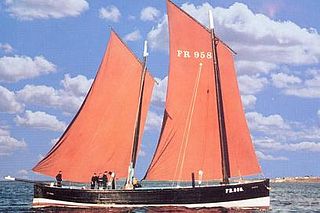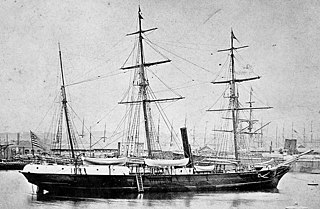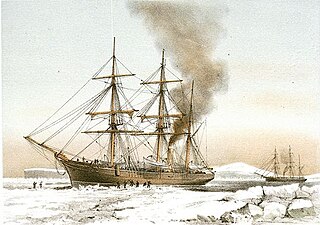This article needs additional citations for verification .(September 2018) |
Black Watch was a large full-rigged ship built by Windsor shipbuilder Bennett Smith in Windsor, Nova Scotia. It was the last ship built by Smith in Windsor.
This article needs additional citations for verification .(September 2018) |
Black Watch was a large full-rigged ship built by Windsor shipbuilder Bennett Smith in Windsor, Nova Scotia. It was the last ship built by Smith in Windsor.
Bennett Smith was the foremost owner, designer and master shipbuilder in Windsor. He ran a shipyard inherited from his father on Smith's Island, at the intersection of the Avon and St. Croix Rivers. With his brothers he built 27 ships in Windsor, the final one being the full-rigged, 1318-ton Black Watch. The ship cost $50,000.00 to construct and was launched in May 1877 to great fanfare. Upon completion of Black Watch, Smith closed his shipyard, reportedly over a wage dispute with his employees. Smith continued to invest in shipbuilding, mainly in Saint John, New Brunswick, and was a principal in the Avon Marine and Shipowners Insurance Company.
Black Watch sailed from Windsor on 6 June 1877 bound for New York in ballast (heavy material placed in hold for stability). On board were a crew of 23 under the leadership of the veteran Captain Newcomb, who along with Smith held shares in the ownership of the vessel. Having taken on a cargo of oil, the ship sailed for Bremerhaven, Germany, on 17 July 1877, arriving on 20 August.
The ship left Germany in ballast (700 tons of stone and sand) on 10 September to cross the Atlantic and return to New York. Disaster struck as the ship attempted to navigate the waters between Shetland and Orkney in the north of Scotland. Black Watch was driven onto the rocks off the southwest point of Fair Isle [1] while attempting to navigate the channel at night in misty weather. The crew, the ship's provisions as well as the sails and any salvageable hardware were all saved.
As recorded in the wreck report, Newcomb was negligent in attempting passage of a channel unfamiliar to him. The court determined that if the Captain was unable to obtain clear and concise instructions for navigating through the Scottish islands as he claimed, he should not have undertaken such a difficult and perilous passage. The court's final determination was that the accident was an error in judgment, but Newcomb's certificate was neither suspended nor revoked. [2]

A clipper was a type of mid-19th-century merchant sailing vessel, designed for speed. Clippers were generally narrow for their length, small by later 19th century standards, could carry limited bulk freight, and had a large total sail area. "Clipper" does not refer to a specific sailplan; clippers may be schooners, brigs, brigantines, etc., as well as full-rigged ships. Clippers were mostly constructed in British and American shipyards, though France, Brazil, the Netherlands and other nations also produced some. Clippers sailed all over the world, primarily on the trade routes between the United Kingdom and China, in transatlantic trade, and on the New York-to-San Francisco route around Cape Horn during the California Gold Rush. Dutch clippers were built beginning in the 1850s for the tea trade and passenger service to Java.

A lugger is a sailing vessel defined by its rig, using the lug sail on all of its one or several masts. They were widely used as working craft, particularly off the coasts of France, England, Ireland and Scotland. Luggers varied extensively in size and design. Many were undecked, open boats, some of which operated from beach landings. Others were fully decked craft. Some larger examples might carry lug topsails.

USSJeannette was a naval exploration vessel which, commanded by George W. De Long, undertook the Jeannette expedition of 1879–1881 to the Arctic. After being trapped in the ice and drifting for almost two years, the ship and her crew of 33 were released from the ice, then trapped again, crushed and sunk some 300 nautical miles north of the Siberian coast. The entire crew survived the sinking, but eight died while sailing towards land in a small cutter. The others reached Siberia, but 12 subsequently perished in the Lena Delta, including De Long.

PNS Rah Naward is a sail training ship of the Pakistan Navy. She was commissioned in 2001 as Prince William for the Tall Ships Youth Trust and sold in 2010 to the Pakistan Navy and renamed Rah Naward.

William Henry Webb was a 19th-century New York City shipbuilder and philanthropist, who has been called America's first true naval architect.
The West Coast lumber trade was a maritime trade route on the West Coast of the United States. It carried lumber from the coasts of Northern California, Oregon, and Washington mainly to the port of San Francisco. The trade included direct foreign shipment from ports of the Pacific Northwest and might include another product characteristic of the region, salmon, as in the schooner Henry Wilson sailing from Washington state for Australia with "around 500,000 feet of lumber and canned salmon" in 1918.

Thomas W. Lawson was a seven-masted, steel-hulled schooner built for the Pacific trade, but used primarily to haul coal and oil along the East Coast of the United States. Named for copper baron Thomas W. Lawson, a Boston millionaire, stock-broker, book author, and president of the Boston Bay State Gas Co., she was launched in 1902 as the largest schooner and largest sailing vessel without an auxiliary engine ever built.

When launched in 1853, Great Republic was the largest wooden ship in the world. She shared this title with another American-built ship, the steamship Adriatic. She was also the largest full-rigged ship ever built in the United States. She was built by Donald McKay for trade on his own account to Australia.
Bennett Smith was a shipbuilder and shipowner in Nova Scotia, Canada. Smith briefly served as a member of the Nova Scotia House of Assembly for Hants County in 1858 and 1859 as a Liberal member.

HMS Discovery was a wood-hulled screw expedition ship, and later storeship, formerly the sealing ship Bloodhound built in 1873 in Dundee. She was purchased in 1874 for the British Arctic Expedition of 1875–1876 and later served as a store ship. Discovery was sold in 1902, reverting to the name Bloodhound and her previous sealing trade. The ship was wrecked in Newfoundland in 1917.

Manchester was a four-masted, steel-hulled British barque which was wrecked in late 1900 on the reefs of Bikar Atoll, Marshall Islands.

Matthew Turner was an American sea captain, shipbuilder and designer. He constructed 228 vessels, of which 154 were built in the Matthew Turner shipyard in Benicia. He built more sailing vessels than any other single shipbuilder in America, and can be considered "the 'grandaddy' of big time wooden shipbuilding on the Pacific Coast."

The County of Peebles was the world's first four-masted, iron-hulled full-rigged ship. It was built during 1875, by Barclay Curle Shipbuilders in Glasgow, Scotland, for the shipping company R & J Craig of Glasgow. Measuring 81.2 metres long, with a beam of 11.8 metres, a draught of 7.1 metres and a cargo capacity of 1,614 net register tons (NRT), it was a state-of-the-art windjammer when it began its use, for the jute trade between the ports of Dundee and Cardiff in Great Britain and Bombay and Calcutta / Hooghly River in East India. Its rig was 'Scottish style', with royal sails above double top-sails and single topgallants.
William Scott Shipbuilders was a short lived shipbuilder in Bristol, England in the 19th century and an early producer of steamships. The yard was important in the development of Bristol Shipbuilding with Scott's assistant, William Patterson, going on to produce the SS Great Britain.
William Patterson Shipbuilders was a major shipbuilder in Bristol, England during the 19th century and an innovator in ship construction, producing both the SS Great Western and SS Great Britain, fine lined yachts and a small number of warships.
Thomas Jefferson Southard was an American shipbuilder, ship owner, entrepreneur, politician and philanthropist, who is considered one of the founding fathers of Richmond, Maine. Southard rose from humble origins to found T. J. Southard & Co., later known as T. J. Southard & Son, the largest shipyard in Richmond in its day and one of the most productive in the state, turning out between 75 and 100 wooden-hulled sailing ships over the course of about 44 years, including some of the largest and best known Maine-built ships of the era. Southard retained a majority share in many of the ships he built, thus building and controlling his own merchant fleet.

The barque Tikoma was built in Richibucto, New Brunswick, Canada, by John and Thomas Jardine, nephews of the ship builder John Jardine. She was registered in 1877 in Chatham, New Brunswick and sold to O. C. Hansen in 1889. Tikoma was sold to C. Apenes and Son of Fredrikstad, Norway in 1897, and sold once more to Th. Andresen in 1906. She ran aground off Pictou, Nova Scotia, in 1909, and was lost.
Codseeker was a fishing schooner launched in April, 1877 that capsized east of Cape Sable Island, at the southwestern tip of Nova Scotia.
Gilmore, was a merchant ship built at Sulkea, opposite Calcutta, British India, in 1824. In 1829-30 she made a voyage delivering settlers to the Swan River Colony in Western Australia. She then made two voyages transporting convicts from England to Tasmania.